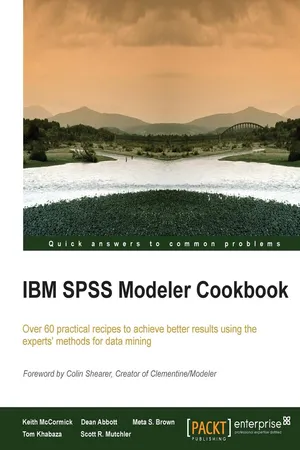![]()
IBM SPSS Modeler Cookbook
![]()
Table of Contents
IBM SPSS Modeler Cookbook
Credits
Foreword
About the Authors
About the Reviewers
www.PacktPub.com
Support files, eBooks, discount offers, and more
Why Subscribe?
Free Access for Packt account holders
Instant Updates on New Packt Books
Preface
What is CRISP-DM?
Data mining is a business process
The IBM SPSS Modeler workbench
A brief history of the Clementine workbench
Historical introduction to scripting
What this book covers
Who this book is for
Conventions
Reader feedback
Customer support
Downloading the example code
Errata
Piracy
Questions
1. Data Understanding
Introduction
Using an empty aggregate to evaluate sample size
Getting ready
How to do it...
How it works...
There's more...
A modified version
See also
Evaluating the need to sample from the initial data
Getting ready
How to do it...
How it works...
There's more...
See also
Using CHAID stumps when interviewing an SME
Getting ready
How to do it...
How it works...
See also
Using a single cluster K-means as an alternative to anomaly detection
Getting ready
How to do it...
How it works...
There's more...
Using an @NULL multiple Derive to explore missing data
Getting ready
How to do it...
How it works...
See also
Creating an Outlier report to give to SMEs
Getting ready
How to do it...
How it works...
See also
Detecting potential model instability early using the Partition node and Feature Selection node
Getting ready
How to do it...
How it works...
See also
2. Data Preparation – Select
Introduction
Using the Feature Selection node creatively to remove or decapitate perfect predictors
Getting ready
How to do it...
How it works...
There's more...
See also
Running a Statistics node on anti-join to evaluate the potential missing data
Getting ready
How to do it...
How it works...
See also
Evaluating the use of sampling for speed
Getting ready
How to do it...
How it works...
There's more...
See also
Removing redundant variables using correlation matrices
Getting ready
How to do it...
How it works...
There's more...
See also
Selecting variables using the CHAID Modeling node
Getting ready
How to do it...
How it works...
There's more...
See also
Selecting variables using the Means node
Getting ready
How to do it...
How it works...
There's more...
See also
Selecting variables using single-antecedent Association Rules
Getting ready
How to do it...
How it works...
There's more...
See also
3. Data Preparation – Clean
Introduction
Binning scale variables to address missing data
Getting ready
How to do it...
How it works...
See also
Using a full data model/partial data model approach to address missing data
Getting ready
How to do it...
How it works...
There's more...
See also
Imputing in-stream mean or median
Getting ready
How to do it...
How it works...
There's more...
See also
Imputing missing values randomly from uniform or normal distributions
Getting ready
How to do it...
How it works...
There's more...
See also
Using random imputation to match a variable's distribution
Getting ready
How to do it...
How it works...
There's more...
See also
Searching for similar records using a Neural Network for inexact matching
Getting ready
How to do it...
How it works...
There's more...
See also
Using neuro-fuzzy searching to find similar names
Getting ready
How to do it...
How it works...
There's more...
See also
Producing longer Soundex codes
Getting ready
How to do it...
How it works...
There's more...
See also
4. Data Preparation – Construct
Introduction
Building transformations with multiple Derive nodes
Getting ready
How to do it...
How it works...
There's more...
Calculating and comparing conversion rates
Getting ready
How to do it...
How it works...
There's more...
See also
Grouping categorical values
Getting ready
How to do it...
How it works...
There's more...
Transforming high skew and kurtosis variables with a multiple Derive node
Getting ready
How to do it...
How it works...
There's more...
Creating flag variables for aggregation
Getting ready
How to do it...
How it works...
There's more...
Using Association Rules for interaction detection/feature creation
Getting ready
How to do it...
How it works...
There's more...
Creating time-aligned cohorts
Getting ready
How to do it...
How it works...
There's more...
5. Data Preparation – Integrate and Format
Introduction
Speeding up merge with caching and optimization settings
Getting ready
How to do it...
How it works...
See also
Merging a lookup table
Getting ready
How to do it...
How it works...
See also
Shuffle-down (nonstandard aggregation)
Getting ready
How to do it...
How it works...
There's more...
See also
Cartesian product merge using key-less merge by key
Getting ready
How to do it...
How it works...
There's more...
See also
Multiplying out using Cartesian product merge, user source, and derive dummy
Getting ready
How to do it...
How it works...
There's more...
See also
Changing large numbers of variable names without scripting
Getting ready
How to do it...
How it works...
There's more...
See also
Parsing nonstandard dates
Getting ready
How to do it...
How it works...
There's more...
Nesting functions into one Derive node
Performing clean downstream of a calculation using a Filter node
Using parameter...
